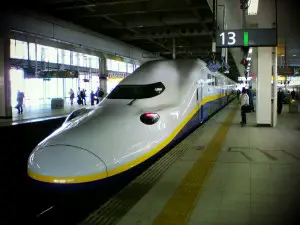Growing up in the countryside in America, I never really got that much exposure to the big city. The only time we saw any kind of mass transportation was a large cargo train that was carrying grain or coal across the country. I got to ride a few trains when I was younger, but it was more for nostalgia than for actual utility.
Trains in America are slow, expensive, and just generally not all that common.
Not like Japan though. Trains are absolutely everywhere in Japan. They are a huge part of the culture. There was a recent jDrama about Train Man or 電車の男 that was really popular, and last year there was a pretty popular movie about the fictional lives of a few people that live along the Hankyu railway.
I didn’t really realize that trains were such a huge part of the culture until I came here and saw that you pretty much have to use a train to do just about anything in Japan. Some people ride on a train for an hour, 2 hours or even 3 hours one way just to get to work.
If you spend that much time on a train, you can start to see why people in Japan have an infatuation with them.
Several Train Lines
It isn’t just one system either. There used to be a national railway called JR that was a public company that connected the entire country together as well as the shinkansen system (bullet train). This company broke off into several private companies with very imaginative names like JR West, JR Central, etc…
This JR system is the main railway, the only railway you can use your rail pass on if you get one when you visit Japan. Residents of Japan (like me) can’t pick up those handy passes unfortunately, so we are stuck paying full price like everybody else, but if you happen to be visiting Japan rail passes are pretty cheap way to see the whole country as long as you keep moving.
JR trains are also notorious for being late. I know I had a co-worker that was inevitably late to work 2 or 3 times a year because the train was delayed.
In addition to JR, you have other train companies with their separate systems. Here in Kansai we have Hankyu, Keihan, Kintestu, Hanshin and Sanyo. Each of them has their own distinct way of doing business.
Hankyu is generally considered to be the upper class railway, mostly because the Hankyu department store is one of the classier department stores in Japan. And then Keihan and Kintetsu usually tie for the middle class while Hanshin is considered the working man’s railway.
These train systems are not only train stops and rails though. At each major stop there are all sorts of railway owned ventures from high-rise apartments to mega malls. Hankyu just recently finished a massive mall that is rumored to be one of the largest in Japan. Meanwhile Keihan has its own amusement park, Hirakata Park.
Types of Cars
Each train system also has its unique system of train cars. Most trains have a women only car that is reserved for just women for all or part of the day. There has even been talk of a men only car, although, I don’t think it has really been taken all that seriously to be honest.
During the summer months, some cars are marked as ‘mild air conditioning’ so that you don’t get blasted with super cold AC on your ride. Hankyu also experimented with a manner car that you could not use any kind of electronic devices in, complete with polite train staff with white gloves telling you to shut off your phones and be quite.
Keihan has also done its best to spice things up a bit by adding some special cars to its express line of trains. The have a TV car where you can watch TV on your way home. There is a single-seater train that has single seats on one side of the train so you can sit by yourself if you’d like. And the best car of all is the double decker.
I personally think there should be a bar car, where you can belly up and have a few drinks on your way home. It could switch to a coffee bar in the morning 🙂
What kind of train car would you like?
What kind of car would you put on your train? If you live in Japan, what are some crazy trains or train cars that you have experienced? Let me know in the comments below.
EDIT: This article got picked up by searchina.ne.jp a big news aggregator site in Japan. You can check out their Japanese summary to practice your reading skills.
Photos by Miki Yoshihito and Elena Gurzhiy
Podcast: Play in new window | Download (Duration: 16:39 — 15.2MB)
Subscribe: RSS














My experiences with trains are rather less than yours. I live in Hokkaido and although I live near a train line (30 minutes by car, a bus goes from my town to that town once a day) and I’ve taken the train from my town to Sapporo a few times a year, but it’s expensive here and when my husband and I did the math, driving is cheaper. Of course, if you live closer to a major urban center, like Sapporo, your experience might be different.
It’s interesting that your write this article: my dad is a train conductor (hobby, not a job) and I’ve been trying to convince him to come visit Japan and my selling point is always “we can take a train somewhere!” but unfortunately, he’s underwhelmed by the notion.
Yeah, I guess I used a little too much hyperbole in this article. I lived out in Shimane for about 2 years before moving to Kyoto, and I hardly used the train.
It just seems like if anybody wants to go somewhere it is by train, not by plane and cars which is what I’m used to coming from the states. For example, when I lived in Shimane and told people I went to Osaka for the weekend, they were surprised I took the bus. It seemed odd to people, but I always took the bus to places because cheaper and easier.
I think it’s just the cities in Japan that use a train system to that extent. I’ve taken the subway in Tokyo, so I have experienced it. But out here in the nowheres-ville of Japan, just like Hilary said, trains are expensive and incredibly inconvenient. You simply cannot survive in the rest of Japan without a car.
I took the train to work once or twice on terribly snowy / icy days during winter; but I wouldn’t do it by choice. I don’t think anyone would.
I admittedly used a little too much exaggeration on this one, I guess I’m speaking from my warped city life view where you take trains and subways to do absolutely anything.
We still own a car and use it quite often too. When I lived in Shimane (next to nowheres-ville Japan) I guess almost everyone drove, but train lines still seemed to form major arteries at least compared to the states. Wouldn’t you agree?
Not to dredge up an old article but I have been enjoying reading through your cultural articles like this one. I did a homestay in Kyoto in July (my first time in japan) this year and loved it. And yes my experience was like yours, trains trains trains… I lived in yamashina and took the jr rail to Kyoto station each day (the joy I experienced once I finally wrangled a one month pass out of the jr ticket office) and then I either took the subway to gojo st or walked (my school was near gojo). I must admit I loved the daily routine, the subway, the train, passing through the ticket gates etc. Anyway I’m taking the N5 in december, studying in japan has comfortably put me past the point where the N5 would be a worry but still, I want to give it my best shot, I’ve been going through the books of sample questions and tests etc. I’ll be sure to report how I get on. Love the site and thanks for all the language help and interesting articles!
Tommy
Ireland
Yeah, you can really get into a rhythm. I have a specific strategy for how to get the best seat and get out of the train quickly. It is so relaxing to sit on the train, working your way through a book, or movie or something and not having to worry about traffic. Anyway, good luck in December!